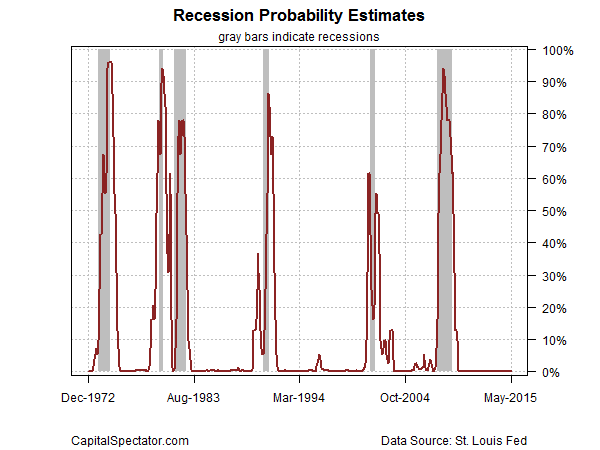Several economic reports in recent weeks have raised questions about the strength and durability of US growth for the near-term future, but a broad review of the numbers through May still suggest that the general trend remains positive. Certain corners of the economy paint a worrisome profile—industrial output, for example. Nonetheless, a diversified mix of indicators from across the US macro spectrum imply that NBER won’t declare May as the start of a new recession.
Using a methodology outlined in Nowcasting The Business Cycle: A Practical Guide For Spotting Business Cycle Peaks, an aggregate of economic and financial trend behavior suggests that business-cycle risk remained low through last month. The Economic Trend and Momentum indices (ETI and EMI, respectively) are still at levels that equate with expansion. The current profile of published indicators through last month (12 of 14 data sets) for ETI and EMI reflect positive trends, with the exception of the corporate bond spread.
Here’s a summary of recent activity for the components in ETI and EMI:
Aggregating the data into business cycle indexes continues to reflect positive trends overall. The latest numbers for ETI and EMI indicate that both benchmarks are well above their respective danger zones: 50% for ETI and 0% for EMI. When the indexes fall below those tipping points, we’ll have clear warning signs that recession risk is elevated. Based on the latest updates for May — ETI is 90.4% and EMI is 5.1% — there’s still a comfortable margin of safety between current values and the danger zones, as shown in the chart. (See note below for ETI/EMI design rules.)
Translating ETI’s historical values into recession-risk probabilities via a probit model also suggests that business cycle risk remains low for the US. Analyzing the data with this methodology implies that the odds are virtually nil that the National Bureau of Economic Research (NBER) — the official arbiter of US business cycle dates— will declare last month as the start of a new recession.
Let’s also consider how ETI may evolve as new data is published. One way to estimate future values for this index is with an econometric technique known as an autoregressive integrated moving average (ARIMA) model, based on calculations via the “forecast” package for R, a statistical software environment. The ARIMA model calculates the missing data points for each indicator, for each month through July 2015. (Note that March 2015 is currently the latest month with a complete set of published data.) Based on today’s projections, ETI is expected to remain well above its danger zone in the near term.
Forecasts are always suspect, of course, but recent projections of ETI for the near-term future have proven to be relatively reliable guesstimates vs. the full set of published numbers that followed. That’s not surprising, given the broadly diversified nature of ETI. Predicting individual components, by contrast, is prone to far more uncertainty in the short run. As such, the latest projections (the four black dots on the right in the chart above) suggest that the economy will continue to expand. The chart above also includes the range of vintage ETI projections published on these pages in previous months (blue bars), which you can compare with the actual data that followed, based on current numbers (red dots). The assumption here is that while any one forecast for a given indicator is likely to be wrong, the errors may cancel out to some degree by aggregating a broad set of predictions. That’s a reasonable assumption via the historical record for the ETI forecasts.
For additional perspective on judging the track record of the forecasts, here are the previous updates for the last three months:
20 May 2015
17 Apr 2015
18 Mar 2015
Note: ETI is a diffusion index (i.e., an index that tracks the proportion of components with positive values) for the 14 leading/coincident indicators listed in the table above. ETI values reflect the 3-month moving average via the transformation rules defined in the table. EMI measures the same set of indicators/transformation rules based on the 3-month average of the median percentage change for the 14 indicators. For the chart showing EMI and ETI through last month, and for the near-term forecasts, the missing data points are estimated with an ARIMA




Pingback: Wall Street National | Jobless Claims Continue To Forecast A Healthy Rise In US Payrolls - Wall Street National